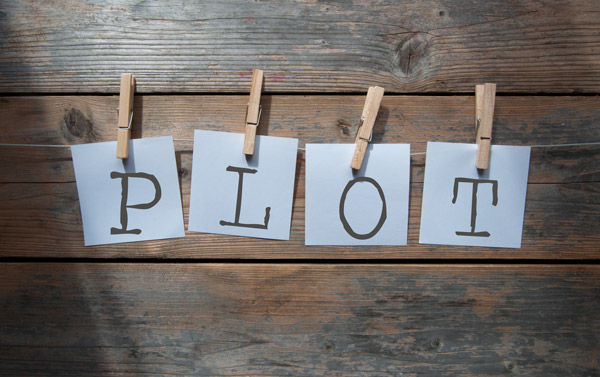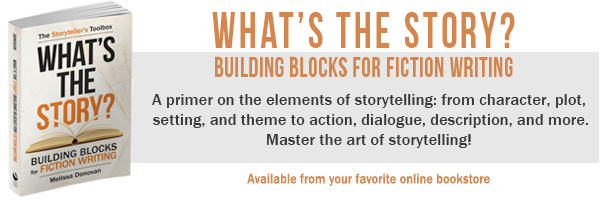Today’s post includes excerpts from What’s the Story? Building Blocks for Fiction Writing, chapter two: “Plot.” It’s a book that lays out the fundamentals of creating fictional stories, equipping you with the basic skills necessary for writing stories that engage. Enjoy!
What is a Plot?
A plot is a sequence of related events in a story.
Plot usually centers around the protagonist’s primary goal or challenge, the central story problem. Each event in the story pushes the protagonist toward a climax where they either succeed or fail to resolve the story problem. In a mystery, the challenge might be to solve a crime. In a romance, the goal is to find true love.
As the plot progresses, the stakes get higher and tensions rise. A killer is on the loose. If the detective doesn’t solve the crime fast, the killer will strike again. As the detective closes in, the killer taunts the detective and threatens his family. Then he kidnaps the detective’s daughter. The situation grows increasingly dire, desperate, or dangerous. The story intensifies at every turn.
The climax is the moment in the story where tension reaches its peak and the stakes are maxed out. The climax occurs near the end of the story and is followed by a resolution, which is when the central story problem (main plot) and all subplots are resolved. Getting to the climax isn’t easy for the characters; otherwise, there would be no story to tell. Therefore, the journey is hard on them, causing a lot of suffering. This results in a satisfying payoff at the story’s end.
In a tightly woven plot, all events are necessary and intertwined with the central conflict. Removing any scene or plot point would break the story. Readers lose interest when a story is filled with unnecessary excess: backstory that isn’t relevant to the plot, lengthy exposition about how a gadget works, and pages of description become tedious. Most readers don’t want to drift too far from the plot, get pulled out of the story, or be confused by tangents.
Readers keep turning pages for two reasons: they care about the characters, and they want to find out what happens. When a plot is well crafted, readers will stick around, because they want to see the detective catch the killer, or they want to see the protagonist find love.
Plot Types and Originality
It’s not uncommon for writers to develop a premise, concept, or entire plot only to realize that something similar has already been done. It’s tempting to throw the idea away and search for something more original. In some cases, that might be a smart move. But most of the time, throwing away an “unoriginal” idea is a mistake.
Plots are built around conflict, but there are only a few conflicts to choose from. There is some debate about how many conflicts exist. Some traditions argue for three; others identify four or more. Here’s a list of six:
- Man vs. man
- Man vs. nature
- Man vs. society
- Man vs. self
- Man vs. machine
- Man vs. supernatural
That’s it. The central conflict of every plot is based on one of these conflicts. Examine any story you can think of, and you’ll be able to classify it as one of these six conflicts.
Think of all the books you’ve read and movies you’ve watched. Can you think of any with a plot that doesn’t fit into one of these? Probably not, and that’s why trying to be original is a useless task.
Tips for Devising a Compelling Plot
- Goals and motives. Build a plot around the protagonist’s goals. What does the hero want? What does the antagonist want? What do the other characters want? Why do the characters want these things? Goals and motives are the driving forces behind the characters’ actions and decisions.
- Stakes. Tensions rise and stakes get higher as the plot unfolds. What will the characters gain if they succeed? What will they lose if they fail?
- Momentum. Make sure every scene and chapter move the plot forward in a meaningful way. If a scene can be cut without changing the story, then that scene is unnecessary.
- Plot versus character. Avoid plots that overshadow the characters, and avoid characters who do little more than guide readers through the plot. A good balance of compelling characters and a gripping plot results in the best possible story.
- Originality. Don’t worry about being original. Focus on developing fresh ideas for your story. Use the other elements—characters, setting, and theme—to enrich your plot and make it feel innovative.
- Resolution. When you finish your draft, make a list of the subplots. Are all subplots and the central plot resolved in a satisfactory way? If you’re planning to write a sequel, did you close the main plot but leave a story thread open?
- Plotting and planning. Making a list of your plot points gives you a good overview of your story, which you can quickly review to check for flow, pacing, conflict, and tension.
- Page-turners. Not all stories are page-turners, but if your goal is to keep readers glued to the story, plan plot points that intrigue and entice them.
To learn more about storytelling and plotting, pick up a copy of What’s the Story? Building Blocks for Fiction Writing.






These are great tips. Thanks for sharing.
You’re welcome.
Awesome information for a new writer such as my self.
Thanks, Brandon. I’m glad you liked this piece.